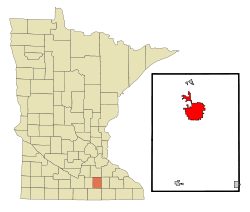Owatonna, Minnesota
| Owatonna, Minnesota | |
|---|---|
| City | |

Downtown Owatonna
|
|
| Nickname(s): O-Town | |
 Location of Owatonna within Steele County and state of Minnesota |
|
| Coordinates: 44°5′14″N 93°13′28″W / 44.08722°N 93.22444°W | |
| Country | United States |
| State | Minnesota |
| County | Steele |
| Incorporated as town | August 9, 1858 |
| Named for | Straight River |
| Government | |
| • Type | Representative council |
| • Mayor | Tom Kuntz |
| Area | |
| • Total | 14.62 sq mi (37.87 km2) |
| • Land | 14.53 sq mi (37.63 km2) |
| • Water | 0.09 sq mi (0.23 km2) |
| Elevation | 1,152 ft (351 m) |
| Population (2010) | |
| • Total | 25,599 |
| • Estimate (2015) | 25,725 |
| • Density | 1,761.8/sq mi (680.2/km2) |
| Time zone | Central (CST) (UTC-6) |
| • Summer (DST) | CDT (UTC-5) |
| ZIP code | 55060 |
| Area code(s) | 507 |
| FIPS code | 27-49300 |
| GNIS feature ID | 0649095 |
| Website | City of Owatonna |
Owatonna (/ˌoʊwəˈtɒnə/) is a city in Steele County, Minnesota, United States. The population was 25,599 at the 2010 census. It is the county seat of Steele County. Owatonna is home to the Steele County Fairgrounds, which hosts the Steele County Free Fair in August.
Interstate 35 and U.S. Highways 14, and 218 are three of the main routes in the city.
Owatonna was first settled in 1853 around the Straight River. The community was named after the Straight River, which in the Dakota language is Wakpá Owóthaŋna. The earliest the Owatonna area was settled was in 1854 and platted in September 1855, but it was incorporated as a town August 9, 1858, then as a city on February 23, 1865.
In 1856, Josef Karel Kaplan emigrated from a village southwest of Prague Bohemia (now the Czech Republic) and selected a quarter section (160 acres (65 ha)) of land near the town of Owatonna. Kaplan described Owatonna as having just 50 small homes, but predicted 100 within a year, along with a railroad. With just four stores and a pharmacy, Owatonna quickly prospered and grew to 1500 inhabitants in just 5 years. Kaplan wrote about the Owatonna area in letters donated to the Minnesota Historical Society. In them he described often seeing Indians – people with "tough constitutions...brown skin and good dispositions", explaining: "When you read about battles between whites and Indians, it is the whites who are to blame." In 1866, Kaplan helped organize the Catholic Cemetery, and a year later, the National Bohemian Cemetery of Owatonna
...
Wikipedia
